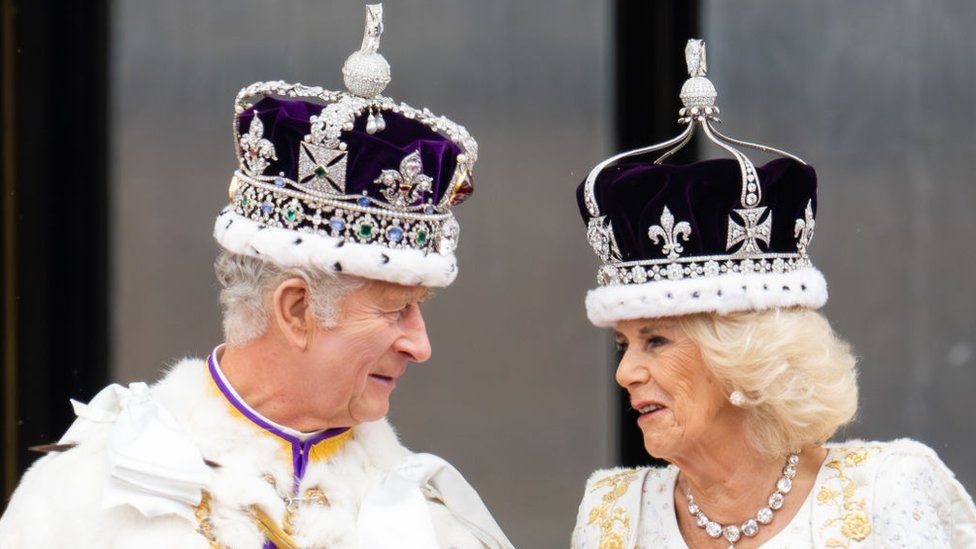
By Jennifer Clarke
BBC News
Millions of people around the world watched the Coronation of King Charles III at Westminster Abbey.
Queen Camilla was also crowned as part of the lavish ceremony, which was followed by a huge procession through London.
What does the King do?
The King is the UK head of state. However, his powers are largely symbolic and ceremonial, and he remains politically neutral.
He receives daily dispatches from the government in a red leather box, including briefings ahead of important meetings, or documents needing his signature.
The prime minister normally meets the King on a Wednesday at Buckingham Palace, to keep him informed on government matters.
These meetings are completely private and there is no official record of what is said.
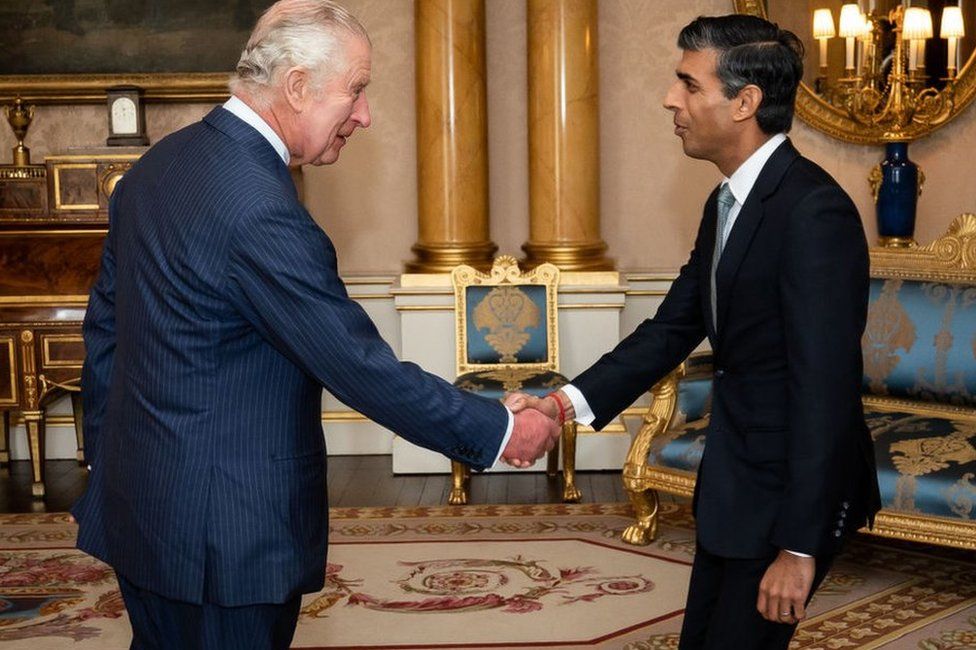
The King also has a number of official parliamentary roles:
- Appointing a government – the leader of the party that wins a general election is usually called to Buckingham Palace, where they are invited to form a government. The King also formally dissolves a government before a general election
- State Opening and the King’s Speech – the King begins the parliamentary year with the State Opening ceremony, where he sets out the government’s plans in a speech delivered from the throne in the House of Lords
- Royal Assent – when a piece of legislation is passed through Parliament, it must be formally approved by the King in order to become law. The last time Royal Assent was refused was in 1708
In addition, the monarch leads the annual Remembrance event in November at the Cenotaph in London.
The King also hosts visiting heads of state – such as South African President Cyril Ramaphosa – and regularly meets foreign ambassadors and high commissioners based in the UK.
For his first state visit, Charles visited Germany, where he became the first British monarch to address the German parliament.
The King is also head of the Commonwealth, an association of 56 independent countries spanning 2.5 billion people – and head of state for 14 of these, known as the Commonwealth realms, as well as the Crown dependencies: the Channel Islands and the Isle of Man.
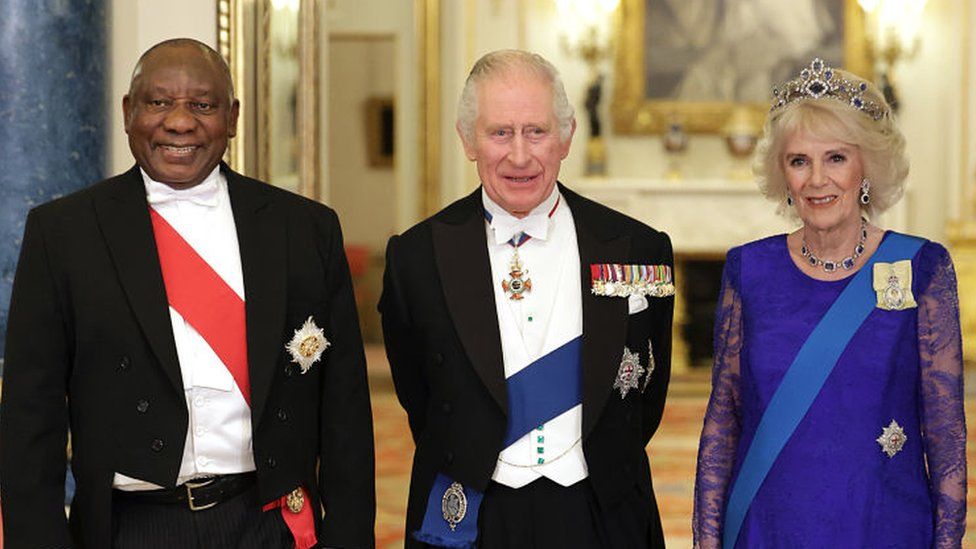
The Queen supports the King in carrying out his work and undertakes her own public engagements on behalf of the 90 charities she supports.
Many of these focus on health and wellbeing, and work with people who have been raped or sexually assaulted.
What happened at the Coronation?
Charles and Camilla were crowned by the Archbishop of Canterbury in front of more than 2,000 guests, including global politicians, fellow kings and queens, religious leaders, celebrities and community champions.
During the ceremony at Westminster Abbey, the King was anointed with “holy oil”, and received the orb and sceptre, symbols of royalty.
https://emp.bbc.com/emp/SMPj/2.49.3/iframe.htmlMedia caption,
Watch King Charles III be crowned
Afterwards, huge crowds lined the streets of central London to watch the King and Queen return to Buckingham Palace in a lavish mile-long procession which featured more than 4,000 members of the armed forces drawn from the UK and the Commonwealth.
Take That and Katy Perry headlined a star-studded concert at Windsor Castle, which also featured representatives from the Royal Shakespeare Company, the Royal Ballet, the Royal College of Music and the Royal Opera.
On the final day of Coronation celebrations, several members of the Royal Family joined volunteers at projects across the UK. Thirty thousand charities arranged 55,000 events as part of the Big Help Out initiative.
More than 60 protesters were arrested during the Coronation, including the head of the anti-monarchy group Republic, Graham Smith.
- King and Queen say thanks for ‘glorious occasion’
- The Coronation: Six takeaways from a historic day
- What it was really like inside the Abbey
Who else is in the Royal Family?
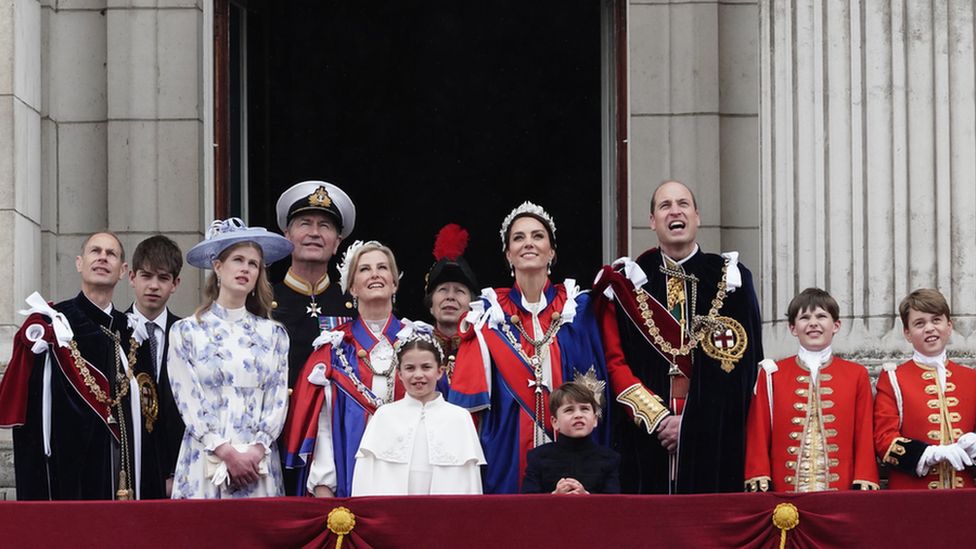
- Prince William is the elder son of King Charles and his first wife, the late Princess Diana. After the death of the Queen, he became the Prince of Wales and Duke of Cornwall while retaining his previous Duke of Cambridge title. He is married to Catherine, Princess of Wales and Duchess of Cornwall and Cambridge. They have three children: Prince George, Princess Charlotte and Prince Louis
- The Princess Royal (Princess Anne) was the Queen’s second child and only daughter. She is married to Vice Adm Timothy Laurence. She has two children with her first husband, Captain Mark Phillips: Peter Phillips and Zara Tindall
- The Duke of Edinburgh (Prince Edward) was the Queen’s youngest child. He is married to the Duchess of Edinburgh (Sophie Rhys-Jones). They have two children: Lady Louise and James, Earl of Wessex
- The Duke of York (Prince Andrew) was the Queen’s second son. He has two daughters with his former wife, the Duchess of York (Sarah Ferguson): Princess Beatrice and Princess Eugenie. Prince Andrew stepped down as a “working Royal” in 2019 after a controversial BBC Newsnight interview about allegations that he had sexually assaulted Virginia Giuffre. In February 2022, he paid an undisclosed sum to settle the civil sexual assault case Ms Guiffre had brought against him in the US
- The Duke of Sussex (Prince Harry) is William’s younger brother. He is married to the Duchess of Sussex (Meghan Markle). They have two children: Prince Archie and Princess Lilibet. In 2020, they announced they were stepping back as senior royals and moved to California
How does succession work?
The order of succession sets out which member of the Royal Family takes over as monarch when the existing one dies or abdicates. First in line – the heir to the throne – is the monarch’s eldest child.
Royal succession rules were amended in 2013 to ensure that sons would no longer take precedence over their older sisters.
King Charles’s heir is his elder son, the Prince of Wales.
William’s eldest child Prince George is second-in-line to the throne, and his daughter Princess Charlotte is third. Prince Louis is fourth and Prince Harry fifth.
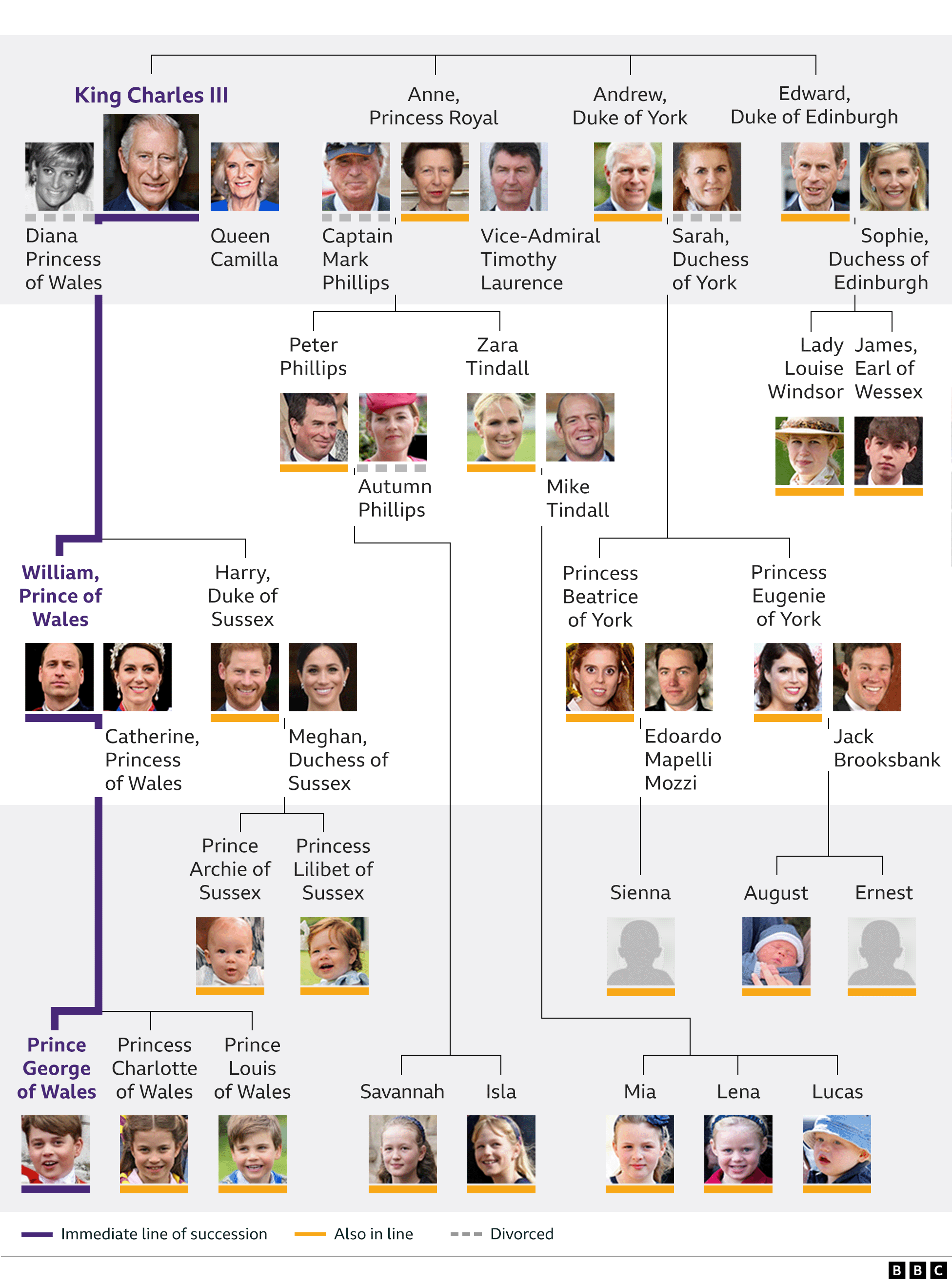
How popular is the Royal Family?
To gauge the public mood ahead of the coronation, Panorama commissioned a new YouGov opinion poll.
The results suggest broad support for keeping the monarchy, with 58% preferring it to an elected head of state – which was supported by 26%.
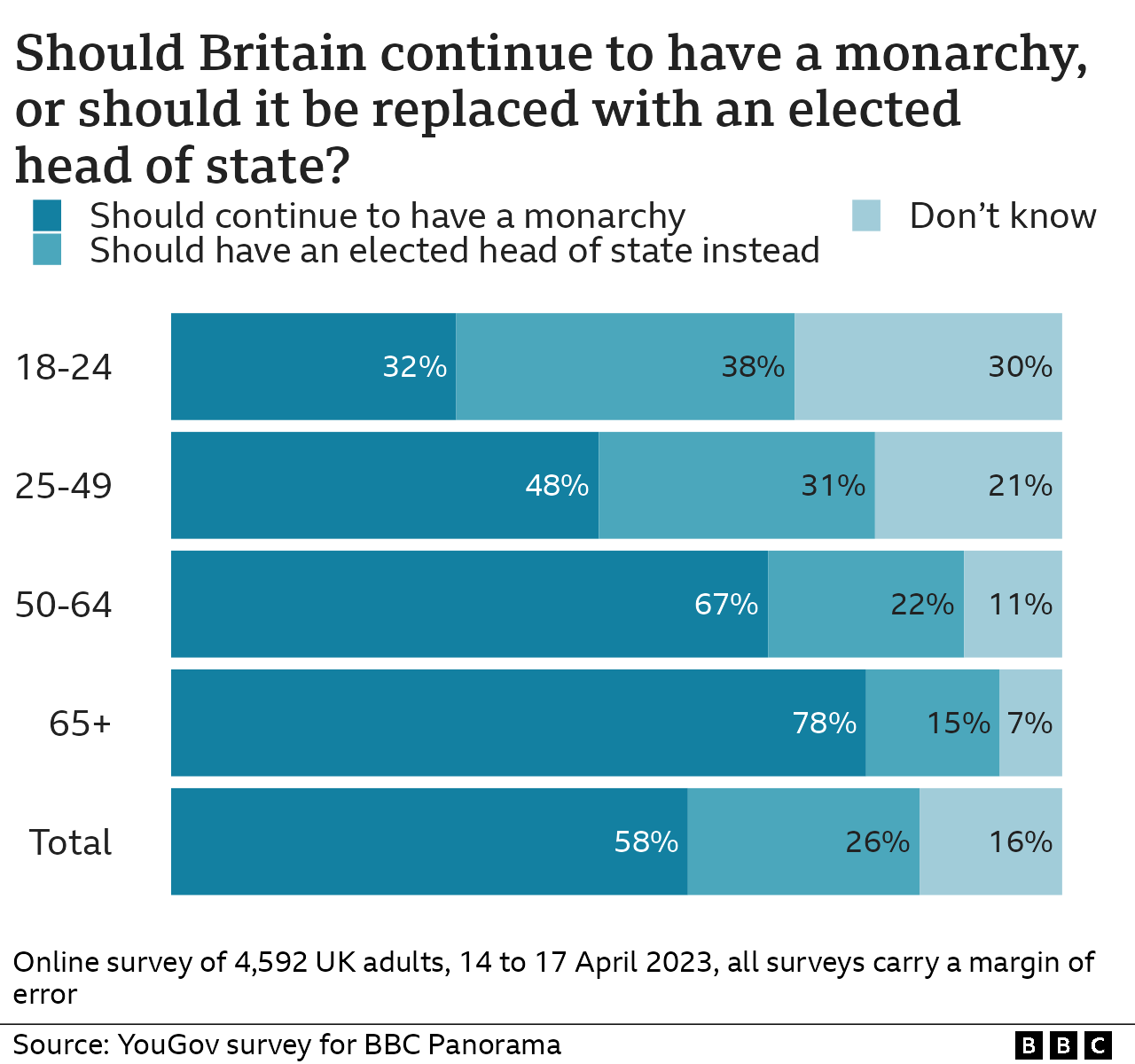
But, below the headline figures, the poll highlights how attitudes differ across age groups. In particular, the monarchy seems to have a problem appealing to young people.
While over-65s were the most likely to be supportive of the monarchy at 78%, 18-24-year-olds were the least likely. Only 32% backed the monarchy. This younger group was more likely, at 38%, to prefer an elected head of state, although the remaining 30% didn’t know.
Indifference could be an issue as much as opposition, with 78% of the younger age group saying they were “not interested” in the Royal Family.


![TELEMMGLPICT000334990121_trans_NvBQzQNjv4Bque3yD-SZ3qWKzlrLhxNXrjXaG_3FkRG2WH2SGzlVXbs[1] UK Royal Family: What does the King do?](https://www.americangoldenawards.com/wp-content/uploads/2023/06/TELEMMGLPICT000334990121_trans_NvBQzQNjv4Bque3yD-SZ3qWKzlrLhxNXrjXaG_3FkRG2WH2SGzlVXbs1-860x538.jpeg)